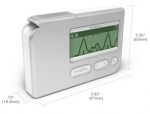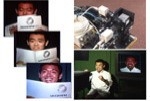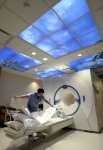Dec 06, 2005
Tangibility in Gameplay
Ana Paiva, Rui Prada, Ricardo Chaves, Marco Vala, Adrian Bullock, Gerd Andersson, and Kristina Hook, ICMI’03, November 5–7, 2003, Vancouver, British Columbia, Canada.
In this paper, we describe a way of controlling the emotional states of a synthetic character in a game (FantasyA) through a tangible interface named SenToy. SenToy is a doll with sensors in the arms, legs and body, allowing the user to influence the emotions of her character in the game. The user performs gestures and movements with SenToy, which are picked up by the sensors and interpreted according to a scheme found through an intial Wizard of Oz study. Different gestures are used to express each of the following emotions: anger, fear, happiness, surprise, sadness and gloating. Depending on the expressed emotion, the synthetic character in FantasyA will, in turn, perform different actions. The evaluation of SenToy acting as the interface to the computer game FantasyA has shown that users were able to express most of the desired emotions to influence the synthetic characters, and that overall, players, especially children, really liked the doll as an interface."
Read full paper:
Towards Tangibility in Gameplay: Building a Tangible Affective Interface for a Computer Game [pdf]
21:20 Posted in Emotional computing | Permalink | Comments (0) | Tags: Positive Technology, Emotional technology
Sep 14, 2005
The Stress Eraser
Via Medgadget
The Stress Eraser from Helicor claims to reduce cronic stress. Designed by Frog design, Stress Eraser is a standalone device that induces relaxation through breathing exercises programmed in. 
I prefer a glass of wine, but the design is nice-looking
13:25 Posted in Emotional computing | Permalink | Comments (0) | Tags: Positive Technology, Emotional technology
Sep 01, 2005
Coloring emotions
Via Siggraph 2005 Emerging Technologies web-site
Color-Enhanced Emotion is a system that recognizes facial expressions and controls skin-pigment components using a real-time processor to enhance them.
 Developed by Toshiya Nakaguchi and coll. from Chiba University, the installation uses computer vision techniques to recognize feelings expressed in facial images, and then implements a hardware-accelerated real-time processing system to control the pigment components of the skin by replicating a broad range of conditions with color enhancements: fair, suntanned, pale, red-faced, etc. Registration cameras decompose the surface reflection of the face to enhance it with the colors associated with commonly observed emotions.
Developed by Toshiya Nakaguchi and coll. from Chiba University, the installation uses computer vision techniques to recognize feelings expressed in facial images, and then implements a hardware-accelerated real-time processing system to control the pigment components of the skin by replicating a broad range of conditions with color enhancements: fair, suntanned, pale, red-faced, etc. Registration cameras decompose the surface reflection of the face to enhance it with the colors associated with commonly observed emotions.
According to Nakaguchi and his colleagues, the Color-Enhanced Emotion project may impulse the development of a new communication paradigm and a lead to the creation of new generation of video-editing technology.
14:40 Posted in Emotional computing | Permalink | Comments (0) | Tags: Positive Technology, Emotional technology
Aug 05, 2005
Does technology make us happy?
As designers and social innovators, should we take any notice of technology policy? Wouldn't it be best to ignore the think-tanks and telcos, and concentrate on doing great projects in the real world? A 90% focus on projects would probably be healthy. But we also need to keep half an eye on policy making because that's where priorities for research spending - and hence the projects we are able to do - are made.
Tech policy is not a pretty picture right now. After a few years in which social issues were visible on the agenda, tech-push is fighting back. In the European Union, for example, the Information Society Technologies (IST) programme contains a lot of tech but not much soc. The IST's aim is to 'master technology and its applications, and help strengthen industrial competitiveness'. Documents mention the need to 'address the main European societal challenges' - but the advisory group that interprets that statement, ISTAG, consists wholly of Big Tech and Big Research interests. (To compound the imbalance, ISTAG comprises 29 men and just four women). There once existed a panel of High-Level Socio-Economic Experts but they quietly disappeared in 2003, supplanted by an entity called eEurope. The main job of eEurope is to 'develop modern public services and a dynamic environment for e-business through widespread availability of broadband access at competitive prices and a secure information infrastructure'. Once again: a lot about tech and not much about soc. >>MORE
17:35 Posted in Emotional computing | Permalink | Comments (0) | Tags: Positive Technology, Emotional technology
Jul 07, 2005
Virtual sky helps patients to relax during cancer radiation therapy
Via the Presence Listserv
Mercy Therapeutic Radiology Associates use manmade skyscape to provide a comfortable ambience during radiation therapy. The images help patients relax and lie still during treatments. 
The manmade skyscape, called a SkyCeiling, is produced by Fairfield-based company called the Sky Factory. The circular SkyCeiling features a pale sliver of a moon hanging against a deep blue sky, tree branches speckled with bright green leaves and gauzy white clouds.
Mercy Therapeutic Radiology has three SkyCeilings, the first installed in late 2003. The hospital also invested in three virtual windows made by the Sky Factory, with landscapes that use a window as the point of reference.
Each virtual window costs $2,000 to $3,000. The ceiling murals cost from $3,000 to $13,000.
11:40 Posted in Emotional computing | Permalink | Comments (0) | Tags: Emotional technology






